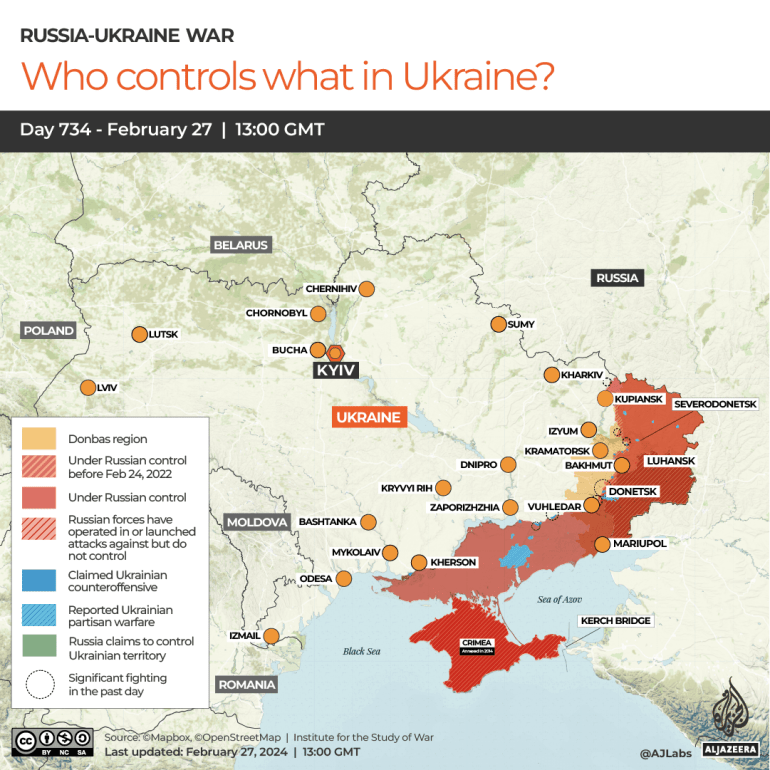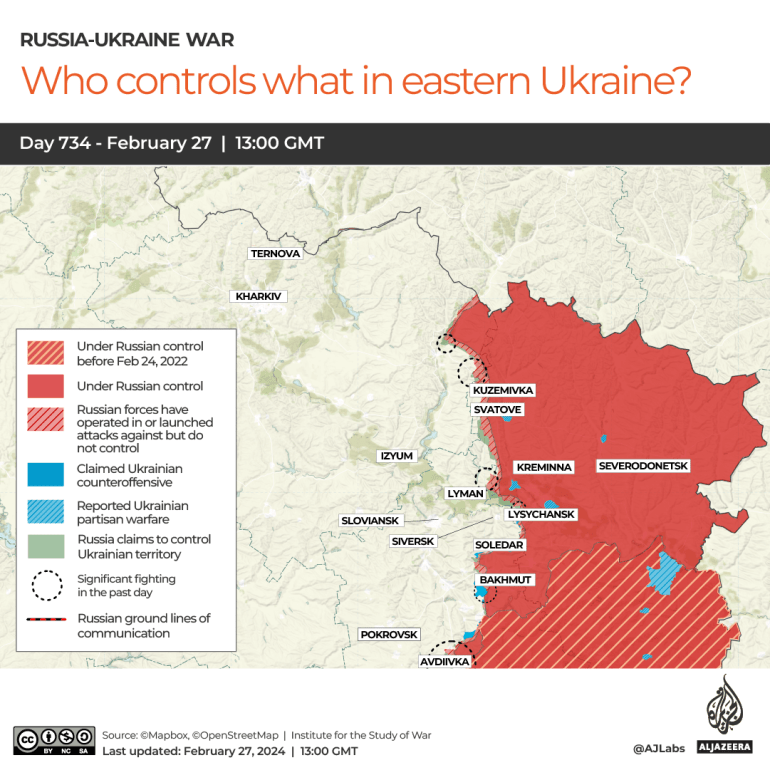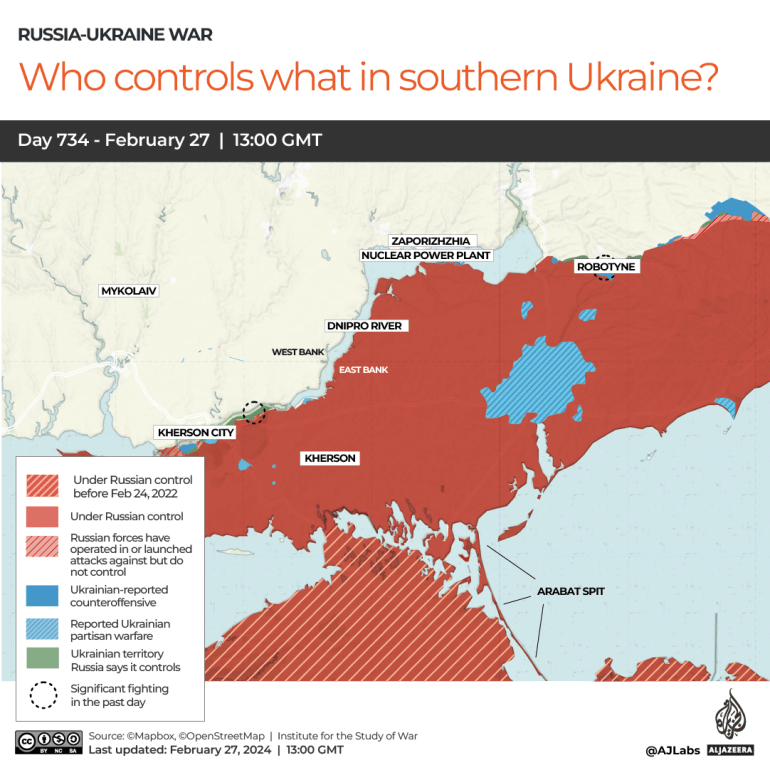
Ukrainian forces in the east struggled to find stable new defences during the past week, as Russian troops continued to advance after capturing Avdiivka – suggesting that artillery and other shortages were affecting Ukraine’s ability to hold the entire 1,000km (620-mile) front line.
Ukrainian forces withdrew from Avdiivka on February 17, after a four-month Russian onslaught to take the town.
On February 24, Ukrainian defenders also withdrew from the village of Lastochkyne, three kilometres (1.9 miles) west of Avdiivka, never having had a chance to build proper defences under fire.
“There were no defences built there, and the fighters had to withdraw from the battles in Avdiivka and gain a foothold in the very process of hostilities,” one Ukrainian military reporter known as DeepStateUA wrote on Telegram to his 700,000 followers, predicting that the same would occur at other points of retreat.
Three days later, Ukrainian troops withdrew from the villages of Stepove and Sieverne, north and south of Lastochkyne, after fierce overnight battles.
Oleksandr Tarnavskyi, commander of the Tavria Group of Ukrainian forces, which is fighting in this area, said on February 27 that the line of defence had “stabilised” along Tonenke-Orlivka-Berdychi axis, a row of three villages immediately to the west of Lastochkyne, but even that assumption seemed precarious.
Geolocated footage the following day showed Russian troops at the southeastern approaches to Orlivka.
Tavria spokesman Dmytro Lykhoviy said Russian forces had increased the size of attacking units from squads to platoons or even companies.
A squad can be as small as half a dozen troops. Platoons can be as big as 50, and a company can reach 200 troops.

Russian troops also claimed on February 26 to have advanced to the outskirts of Ivanivske, a village west of Bakhmut, the last city to fall to Russian forces, in May.
And Russian forces reclaimed Robotyne, a village Ukrainian troops recaptured during last summer’s offensive at the western end of the front, in Zaporizhia.
Geolocated footage on February 24 showed Russian troops in the centre of Robotyne, where military reporters said they had secured the central fortified positions in the school and recreational centre.
Russian troops also continued to assault Ukrainian positions in Krynky, on the left bank of the Dnipro River in Kherson, without success.
Control of the air
One reason for Russian success in Avdiivka appears to have been the fact that Moscow’s forces secured local air superiority and used it to drop glide bombs – large, inert weapons fitted with fins to fly further and strike more accurately.
Ukrainian President Volodymyr Zelenskyy said Russia had dropped more than 3,200 glide bombs since the beginning of the year.
Ukraine has targeted Russian bombers and the command planes that coordinate them.
On February 27, Ukraine downed two Sukhoi-34 bombers, at least one of them in the east, which are used to drop glide bombs.
More consequentially, on February 23 the Ukrainian military shot down a Russian A-50 early warning and control plane over the Sea of Azov coast. The A-50 is an airborne radar used to monitor enemy air activity and air defences. Russia has used them to feed target coordinates to fighters, bombers and long-range missiles.
Ukrainian military intelligence chief Kyrylo Budanov said the operation had left Russia with just six A-50 planes in the Ukraine theatre, and that more would be downed.

Zelenskyy told allies gathered in Paris that a strategic goal for this year was to deprive Russia of air superiority, just as it had been deprived of its control of the Black Sea and its superiority on land.
Ukraine has long-targeted these planes, which are very difficult to replace.
Russia only built 40 of them, and crew training takes years. Some reports suggest they will be vital to Russian efforts to shoot down Ukrainian F-16s, once they start flying. Western allies have promised to hand Ukraine at least two dozen.
A year ago, fighters bombed the Machulishchi air base in Belarus, where Russia had parked an A-50, damaging it. On January 15, Ukraine downed an A-50 in the Sea of Azov, along with an Ilyushin-22 command plane.
Ukraine also continued ranged attacks on Russian energy and defence infrastructure. On February 24, its military intelligence and security service said they had jointly organised a successful drone attack against the Novolipetsk Metallurgical Plant, in Lipetsk, 370km (230 miles) southeast of Moscow. The plant supplies steel for the manufacture of artillery, missiles and drones.
Russia, too, continued its aerial campaign against Ukrainian infrastructure using missiles and drones. From February 21-28, Ukraine downed 79 Iranian-designed Shahed drones out of 98 launched, along with a number of missiles.
What are Ukraine’s allies doing?
Ukraine’s allies continued to pledge military assistance.
Denmark announced a $228m military aid package including 15,000 rounds of ammunition. Germany announced a new military aid package that included 14,000 artillery rounds and reconnaissance drones.
French President Emmanuel Macron gathered 20 heads of government, including 15 from the EU, in Paris on February 26, to discuss increasing the supply of artillery rounds to Ukraine.
The European Union has said it will be in a position to manufacture a million artillery rounds a year by the end of 2024.
Macron also called for the formation of a new alliance to supply “missiles and bombs of medium and long range to carry out deep strikes”.
France and the UK were the first to supply Ukraine with Storm Shadow/SCALP missiles, with a 140km (87-mile) range, last May. Until then, the longest-range weapon Ukraine had was 80km (50-mile) range HIMARS rockets. The US is now reportedly thinking of supplying 300km range ATACMS missiles, and Ukraine claims it has developed a 700km range (435-mile) missile.

While there was “no consensus” on the sending of Western ground troops to Ukraine, “nothing should be excluded. We will do whatever it takes to ensure that Russia cannot win this war,” Macron said.
Russian President Vladimir Putin responded with a threat of nuclear war, should NATO members send troops to Ukraine.
“[Western nations] must realise that we also have weapons that can hit targets on their territory,” he told assembled lawmakers on Thursday. “All this really threatens a conflict with the use of nuclear weapons and the destruction of civilisation. Don’t they get that?!” said Putin.











